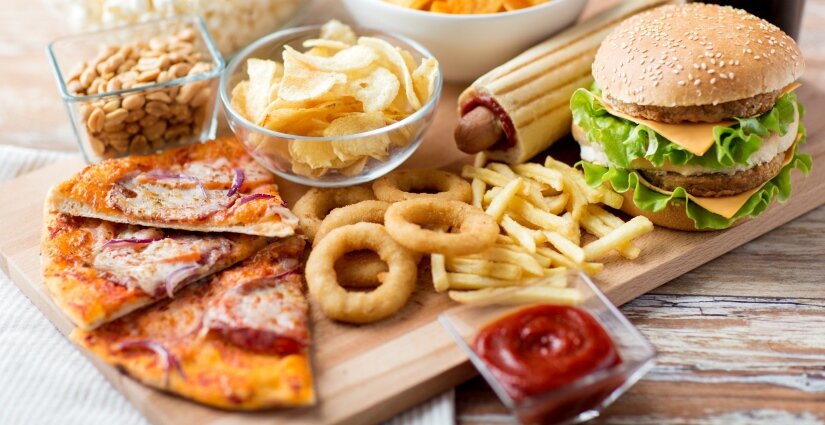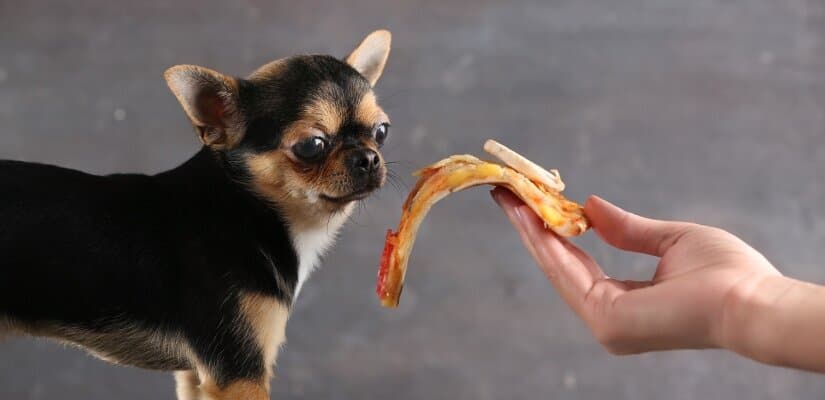You’re probably wondering if salami is safe for your dog? If you’ve ever enjoyed cold meats near your furry best friend, then you’ll know how much he really wants that piece of salami.
In this blog, we’ll discuss why salami is not a good snack for your dog and how consistently feeding it as a treat can actually be dangerous because of the high salt and fat content.
Some salami brands may also contain garlic and onion powders, which are toxic to dogs. Here’s the take with salami for dogs.
Fatty foods: Processed meats like salami, bologna, sausage, and hotdogs are extremely high in fat. This means that your dog’s pancreas can get inflamed, which could cause pancreatitis. Your dog may vomit or get diarrhea after she eats any processed meat like salami, even if your dog has only consumed a small amount.
One example recently was when I witnessed a friend’s dog, Finny, who literally grabbed a piece of salami and some bread off a guest’s plate and swallowed the whole thing. Finny threw up the salami within 20 minutes, proving that salami is definitely on the list of dangerous foods for dogs.
Sulphite preservatives: Processed meats like sausages often contain sulfite preservatives resulting in thiamine deficiency and dogs’ death. If your dog has eaten any processed meats or toxic foods, it’s best to make sure that you don’t continue to feed your dog these products in the future.
Other foods that contain sulfite preservatives may include pizza, potato chips, and alcoholic beverages like wine. Most of these types of foods are served at parties, so you need to make sure your dog is never alone in a room where food is served, most especially during the holidays when you have plenty of guests over.
Other Human Foods with High Fat that are Harmful to Dogs

- French Fries: Yes, French Fries are on the Dangerous Foods for Dogs list because they are loaded with fat. Be careful to keep your plate out of your dog’s reach.
- Fast Food: Your dog can get sick from eating a burger at a fast-food drive-through, so don’t share your fast food or fries with your dog.
- Fried Food: Your dog can get sick from fried chicken or fried foods, including fried vegetables cooked in oil.
Note: Your dog’s digestive system is not the same as yours, so any high fat or rich food is not good for your dog to eat. A diet that’s too high in fat may cause your dog to gain weight and become obese or develop heart problems. If it’s not good for your dog, you may want to consider eliminating that food from your diet as well.
3 Simple Steps to Keep Dangerous Foods for Dogs Away from Your Dog
- Awareness: Your dog depends on you to learn what she can eat and what’s bad for your dog’s health. Question whether all the food and treats you give your dog are healthy. Instruct your family, friends, guests, and strangers to keep all food out of your dog’s reach unless you approve it first.
- Control: Your dog will eat anything she can reach, so you need to take control of your dog’s environment to keep her safe. Make sure that any food you have on your table is not accessible to your dog. This means that you also need to keep a watchful eye on your dog’s behavior with your family and guests who may not be aware of dangerous foods for dogs and also not be able to resist giving your dog a table scrap that’s toxic for your dog.
- Action: If your dog has eaten any dangerous or toxic food, you should immediately bring your dog to your local vet or emergency animal hospital. It’s not a good idea to induce your dog to vomit without proper medical help from a veterinarian.
Onions & Garlic & Anemia
Onions contain n-propyl disulfide, and when dogs ingest this, it damages the lipid membranes of red blood cells. The membrane damage is irreversible. The result is Heinz bodies being produced in the red blood cells because pets are prone to top Heinz body anemia even after consuming as little as 5-10g onions/kg body weight, with this causing anemia.
A study demonstrated that dogs fed 30g onions/kg body weight/day for 3 days suffered from severe anemia. It’s important to keep in mind that garlic is a member of the onion family and causes severe anemia in pets and dermatitis.
Limiting Exposure to Foodborne Illnesses

As a pet parent, it’s important to prevent your dogs from getting into the garbage and consuming whatever is in there. Do not feed any moldy food to dogs. Your dog could also get salmonella from cold meats. This blog gives you facts on why you should not feed your dog processed foods like salami high in fat that may result in pancreatitis.
Is Too Much Salami Bad for Dogs?
If your dog has run off with your salami that he’s just grabbed off the kitchen counter and eaten the entire salami, you’ll need to visit your emergency veterinarian. Dogs may show the following signs after consuming a small amount of salami.
- Vomiting
- Diarrhea
- Excessive thirst
- Gastrointestinal pain
- Vomiting
Because there are so many different salami brands out there, it’s best to refrain from giving your dog any because it can lead to dehydration and pancreatitis. Reach out to your veterinarian if you have any questions regarding cured meat.
Genoa & Cotto Salami
You should not feed Genoa salami to dogs because it has pork, high fats, and wine. The aging process takes place without heat, and this brand of salami is very oily. The problem with this brand is that your dog would be consuming wine, high salts and fat, and pork.
Cotto salami may be a better bet if just a tiny bit is given as a small snack. This salami brand uses high heat during prep processing, and the high heat used makes it safer. But keep in mind you still have high salts and fats, so you should be super careful when feeding as a snack.
When looking at hard salami and dry salami, they all have spices, which could pose a huge health risk if fed often. If you’re considering salami sticks as snacks for dogs, the same issues apply. If your dog consumes too much, there’s a high risk of sodium toxicity or dehydration.
Uncured salami contains less salt than cured salami, yet this type of salami has a high-fat content that is not good for your dog’s heart and digestion. You may be thinking that turkey salami may be a better choice, but it still has high sodium levels.
How Much Salami Can My Dog Eat?
Yes, we’ve all been tempted to feed a tiny bit of salami to our dogs now and then. But think about it this way. If you’re doing so three times a week, calculate that in terms of monthly sodium and fat intake. Here’s the take with how much salami can your dog eat?
Dogs are prone to pancreatitis, and it can be life-threatening. Warning signs include:
- Vomiting
- Abdominal pain
- Anorexia
There are numerous other signs, including fever, depression, abdominal distention, dehydration, and anorexia. With chronic pancreatitis, symptoms are usually weight loss and anorexia. Pancreatitis happens when digestive enzymes are activated in the pancreas.
If your dog has chronic inflammation, he may end up with diabetes mellitus or Exocrine Pancreatic Insufficiency. (EPI) Your vet may suggest intravenous treatment with antibiotics for the treatment of acute pancreatitis. Here’s the take on why it’s not good to feed high fat and salt content foods to dogs.
- High-fat diets can result in maldigestion or malabsorption.
- Breeds most at risk for pancreatitis include Yorkshire terriers, Jack Russell terriers, Chihuahuas, Japanese Spaniels, Labrador Retrievers, Maltese and Shetland Sheepdogs.
Even though salami is not toxic to dogs, there are plenty of reasons why you should refrain from feeding salami to your dog, even as a small snack occasionally.
Depending on your dog’s age, health, and body weight, if you calculate sodium levels per body weight, you’ll then see how much damage this does over time.
Keep in mind that there’s approximately 214 sodium per salami slice, which is pretty high. Dogs should also not consume spicy foods or foods that are high in fats and sodium. Health issues may not occur right away, but you’ll be faced with them at some stage of your dog’s life!
The problem with feeding it as an occasional snack is that it could be fed continuously over a few years and eventually build up to a health issue. By becoming a food-savvy pet parent, you’ll need to understand all you can about what you can feed your furry best friend so that you can protect your dog’s health and promote longevity.
